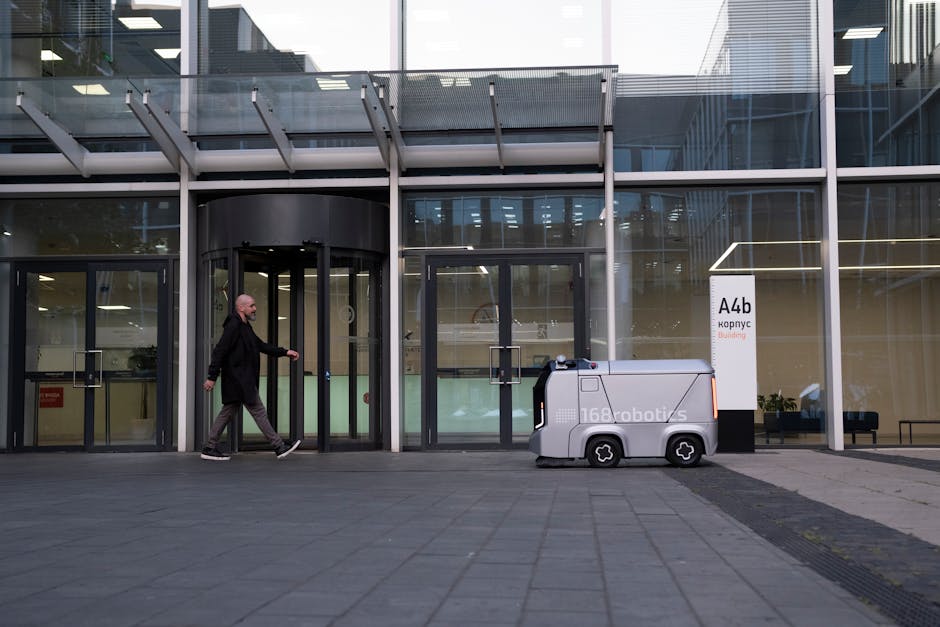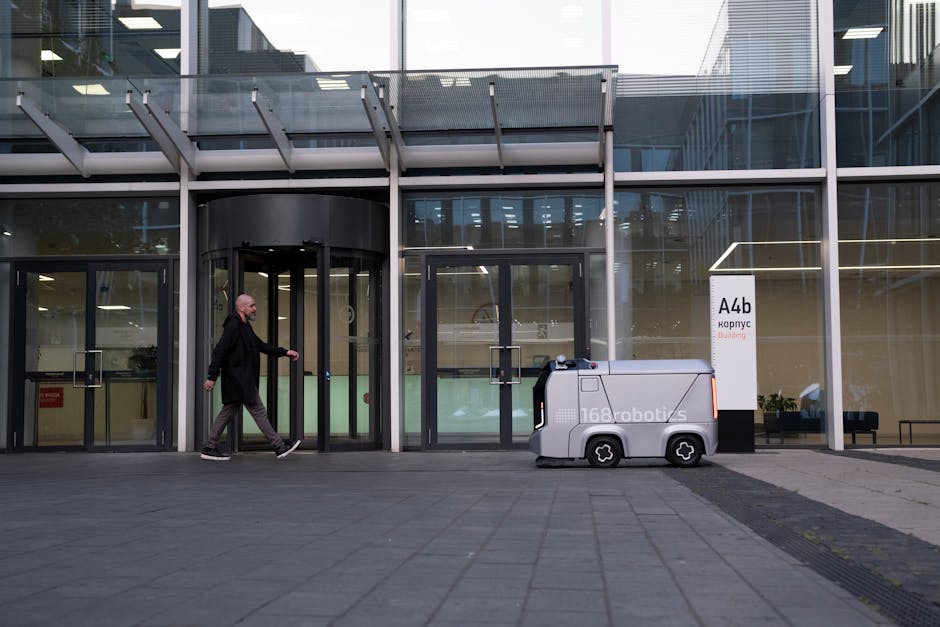Autonomous Vehicles: The Future of Transportation in the Workplace
“Autonomous vehicles are revolutionizing how we think about transportation in corporate and educational settings. This article explores the technology behind self-driving vehicles, their potential benefits for workplace efficiency, and practical considerations for facility managers looking to integrate this technology into their transportation strategies. ”

The Rise of Autonomous Vehicles in Workplace Settings
Autonomous vehicles represent one of the most significant technological advancements of our time, with far-reaching implications for how organizations manage transportation and logistics. For corporate HR managers, IT professionals, facility managers, and educational administrators, understanding this technology and its potential applications is becoming increasingly important as we move toward a future where self-driving vehicles may become standard in workplace settings.

Autonomous vehicles, also known as self-driving cars, are automobiles that employ driver assistance technologies to remove the need for a human operator. These vehicles use a combination of sensors, cameras, radar, and artificial intelligence to navigate their surroundings without human intervention. The technology operates on a scale of autonomy, ranging from basic driver assistance features to fully autonomous operation.
Understanding Autonomy Levels
The Society of Automotive Engineers (SAE) has defined six levels of driving automation, from 0 to 5:
- Level 0: No automation. The driver performs all driving tasks.
- Level 1: Driver assistance. The vehicle can assist with one function, such as steering or acceleration.
- Level 2: Partial automation. The vehicle can handle steering and acceleration/deceleration but requires driver monitoring.
- Level 3: Conditional automation. Under specific conditions, the vehicle can drive itself, but a human driver must be ready to take control when alerted.
- Level 4: High automation. The vehicle is fully self-operational within set boundaries, requiring no driver assistance.
- Level 5: Full automation. The vehicle can operate without boundaries or conditions and requires no human intervention.
Most vehicles currently on the road with "autonomous" features operate at Levels 1 or 2, with some companies like Waymo and Tesla pushing into Levels 3 and 4 for specific applications.
Benefits for Workplace Transportation
For organizations considering the integration of autonomous vehicles into their transportation strategy, several potential benefits make this technology worth exploring:
Enhanced Safety and Reduced Accidents
Self-driving cars are designed to operate safely and logically by detecting and reacting to traffic conditions. They don't get distracted, tired, or impaired, which are common factors in human-caused accidents. This could significantly reduce transportation-related incidents for company fleets and shuttle services.
Increased Efficiency and Productivity
Autonomous vehicles can optimize routes, reduce traffic congestion, and operate continuously without breaks. For corporate campuses or educational institutions with regular shuttle services, this can mean more efficient transportation with less downtime.

Cost Savings
While the initial investment in autonomous vehicle technology may be substantial, long-term savings could be realized through reduced labor costs, lower insurance premiums due to fewer accidents, and more efficient fuel consumption through optimized driving patterns.
Accessibility Improvements
For employees or students with mobility challenges, autonomous vehicles could provide greater independence and accessibility. This aligns with broader workplace optimization goals of creating inclusive environments for all.
Implementation Considerations for Facility Managers
For facility and IT managers considering autonomous vehicle implementation, several factors should be taken into account:
Infrastructure Requirements
Autonomous vehicles may require specific infrastructure modifications, such as dedicated lanes, charging stations for electric autonomous vehicles, or enhanced wireless connectivity for vehicle-to-infrastructure communication.
Data Security and Privacy
Autonomous vehicles generate and process vast amounts of data. Organizations must consider how this data will be secured, who will have access to it, and how to ensure compliance with data privacy regulations.
Integration with Existing Systems
For maximum efficiency, autonomous vehicles should integrate with existing transportation management systems, building access controls, and scheduling software. This requires careful planning and potentially custom development work.

Regulatory Compliance
The regulatory landscape for autonomous vehicles is still evolving. Organizations must stay informed about local, state, and federal regulations governing the use of self-driving vehicles on public roads and private property.
Real-World Applications in Corporate and Educational Settings
Several applications of autonomous vehicle technology are particularly relevant for workplace and educational environments:
Campus Shuttles and Transportation
Large corporate campuses and university grounds can benefit from autonomous shuttle services that transport employees or students between buildings, parking areas, and other facilities. Companies like Waymo have already begun implementing such services in controlled environments.
Delivery and Logistics
Autonomous vehicles can streamline internal logistics operations, such as mail delivery, supply distribution, or food service across large facilities. This can free up staff for more complex tasks while ensuring consistent delivery times.
Parking Optimization
Self-parking vehicles can maximize the use of parking facilities by parking more efficiently and relocating as needed. This can reduce the footprint required for parking and potentially repurpose some parking areas for other uses.
Emergency Response
In emergency situations, autonomous vehicles could be deployed to assist with evacuations or transport emergency equipment, providing an additional layer of safety and response capability.
Challenges and Limitations
Despite the potential benefits, several challenges remain for organizations considering autonomous vehicle implementation:
Technology Reliability
While advancing rapidly, autonomous vehicle technology still faces challenges in certain weather conditions, complex traffic situations, and unexpected scenarios. Organizations must have contingency plans for when technology limitations arise.
User Acceptance
Employees, students, and visitors may have varying levels of comfort with autonomous vehicles. Organizations should plan for education and gradual implementation to build trust and acceptance.
Cost Considerations
The initial investment in autonomous vehicle technology, infrastructure modifications, and ongoing maintenance can be substantial. Organizations should conduct thorough cost-benefit analyses before proceeding.

Liability and Insurance
The question of liability in autonomous vehicle accidents is still evolving. Organizations must work closely with legal and insurance providers to understand their exposure and coverage options.
Preparing Your Organization for Autonomous Vehicles
For facility managers and IT professionals looking to prepare their organizations for the eventual adoption of autonomous vehicles, several steps can be taken now:
Conduct a Transportation Audit
Understand your current transportation needs, pain points, and costs to identify where autonomous vehicles might provide the greatest benefit.
Develop a Technology Roadmap
Create a phased approach to autonomous vehicle adoption that aligns with your organization's broader technology strategy and workflow optimization goals.
Engage with Vendors and Pilot Programs
Many autonomous vehicle manufacturers offer pilot programs for organizations interested in testing the technology. These can provide valuable insights without requiring full-scale implementation.
Update Policies and Procedures
Begin reviewing and updating transportation policies, safety protocols, and information security standards to accommodate autonomous vehicle technology.
The Future of Autonomous Vehicles in the Workplace
Looking ahead, several trends are likely to shape the future of autonomous vehicles in workplace settings:
Integration with Smart Buildings
Autonomous vehicles will increasingly communicate with smart building systems to coordinate arrivals, departures, and passenger needs, creating a seamless transportation experience.
Sustainability Focus
As organizations prioritize sustainability goals, electric autonomous vehicles will likely become the standard, reducing carbon emissions and supporting green initiatives.
Customization for Specific Use Cases
Rather than one-size-fits-all solutions, we'll see more autonomous vehicles designed for specific workplace applications, such as specialized delivery vehicles or accessibility shuttles.
Enhanced Collaboration Tools
Autonomous vehicles may evolve into mobile meeting spaces, equipped with collaboration tools that allow employees to work productively while in transit.
Conclusion
Autonomous vehicles represent a significant opportunity for organizations to reimagine transportation and logistics in workplace settings. While challenges remain, the potential benefits in terms of safety, efficiency, and accessibility make this a technology worth exploring for forward-thinking facility managers, IT professionals, and administrators.
By understanding the current state of autonomous vehicle technology, considering potential applications in your specific context, and taking steps to prepare your organization, you can position yourself to leverage this transformative technology as it continues to mature and become more widely available.
The journey toward autonomous vehicles in the workplace will be gradual, but organizations that begin planning now will be better positioned to realize the benefits while minimizing disruption when wider adoption becomes feasible.